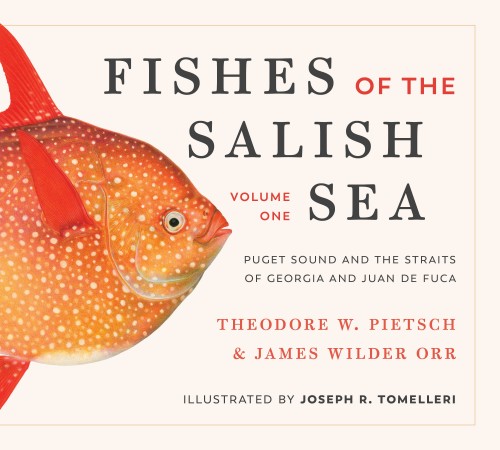
Fishes of the Salish Sea
Review By Leo Bodensteiner
August 30, 2021
BC Studies no. 211 Autumn 2021 | p. 145-146
Having studied fish for more than 40 years, I have accumulated more than 50 “fishes of…” books, latitudinally arranged on my office shelf, and none of them can compare in the quality, quantity, and aesthetics with the boxed three-volume Fishes of the Salish Sea. This 1,048-page compilation of the history, taxonomy, and ecology of its 240 fishes is a crowning achievement in the genre and far exceeds the authors’ stated goals: a practical, useful guide for professional and amateur fish enthusiasts. With such a broad and comprehensive scope of material, it will certainly appeal to those engaged in the scientific study of fish but also those who appreciate the exquisite artistry of scientific illustration.
Volume 1 stands alone from typical regional fish books by providing a comprehensive overview of natural and human elements related to the origins of the fishes, their discovery, and their changing distribution. The contributions of the scientists who described these fishes are encompassed in 73 biographies, including Rosa Smith Eigenmann, a distinguished ichthyologist in the late 1800s who advocated for women as scientists. Another highlight is Joseph Tomelleri’s use of colored pencils to accurately portray anatomical features and color patterns in images that are often far superior to photographs and line drawings for identification and descriptive purposes.
Volumes 2 and 3 present essential ichthyological information in the manner of Hart (1973; out of print) — synonymy and etymology; physical appearance; morphometrics; distinguishing features; life history; distribution; and family-based keys — but are prominently distinguished by an attractive contemporary presentation, additions of key references with subject areas, and a biogeography that distinguishes among eight regions within the Salish Sea. The color illustrations, and 81 separate larger plates, display an intricate level of detail for each fish and give the set a unique utility and beauty. Throughout, use of common language in an articulate, engaging style makes it accessible to those more casually acquainted with fishes; necessary technical terms are defined in an eight-page glossary. And for those using this as a jumping off point for a deeper scientific dive, 84 pages with approximately 2,200 references support the information provided.
The geographically bounded scope of this book set enables much more nuanced understanding of the relation of the physical environment to ecology in this diverse environment with its subset of North Pacific fishes than other books, which primarily serve as field guides for identification. It fulfills that purpose in an exceptional fashion with its concise descriptions and intricate, accurate illustrations and goes well beyond with well-referenced descriptions of distribution, habitat, and life history. The scholarly basis for the subject matter clearly distinguishes it from the two commonly used regional field guides – A Field Guide to Coastal Fishes (Kells et al.) and Coastal Fishes of the Pacific Northwest (Lamb and Edgell). While you might not carry one of these in your dive gear bag for quick identification, the information contained in the three volumes of Fishes of the Salish Sea renders it an essential addition to laboratories and libraries of those who study fishes in this Pacific Northwest ecosystem.
References
Hart, J.L. 1973. Pacific Fishes of Canada. Fisheries Research Board of Canada Bulletin 180. Ottawa.
Kells, V., L.A. Rocha, and L.G. Allen. 2016. A Field Guide to Coastal Fishes. Johns Hopkins University Press, Baltimore.
Lamb, A., and P. Edgell. 2010. Coastal Fishes of the Pacific Northwest, 2nd edition. Harbour Publishing, Madeira Park, BC.
Publication Information
Fishes of the Salish Sea: Puget Sound and the Straits of Georgia and Juan de Fuca
Theodore Wells Pietsch and James Wilder Orr
Illustrated by Joseph R. Tomelleri
Victoria, BC: Heritage House, 2019. 1032 pp. $179.00 hardcover.
